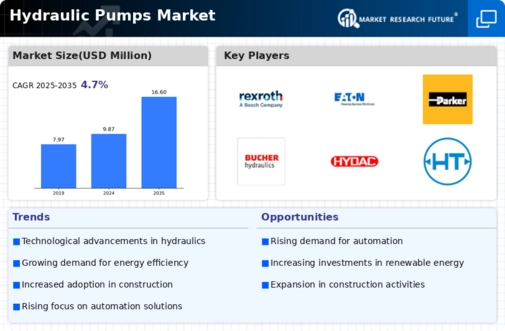Top Industry Leaders in the Hydraulic Pumps Market

*Disclaimer: List of key companies in no particular order
The Hydraulic Pumps Market: Navigating Power and Flow in a Competitive Landscape
In the realm of hydraulic pumps, the competition is intense, and industry players are employing a myriad of strategies to secure their market share and fortify their positions. To delve into this dynamic landscape, it is essential to explore the strategies adopted by key players, analyze market share factors, and identify emerging trends that shape the future of this crucial industrial component.
Key Player Strategies:
Global Reach and Established Networks: Market leaders such as Bosch Rexroth, Parker Hannifin, and Eaton are leveraging their extensive global footprints and well-established distribution networks to maintain dominance. This strategic approach enables them to cater to diverse regional demands and capitalize on economies of scale, resulting in competitive pricing that solidifies their market leadership.
Product Diversification and Specialization: Recognizing the diverse needs of different industries, key players are strategically expanding their product portfolios. Bosch Rexroth, for instance, offers a comprehensive range of pumps catering to construction, mobile hydraulics, and industrial applications. On the other hand, companies like Sun Hydraulics excel in niche segments, such as high-pressure pumps designed for offshore applications.
Technological Innovation and R&D: Staying ahead in the competitive landscape requires continuous advancements in hydraulic technology. Leading players like Parker Hannifin invest significantly in research and development, focusing on enhancing energy efficiency, reducing noise levels, and implementing intelligent control systems. The integration of smart sensors and AI-powered predictive maintenance is redefining pump performance and reliability.
Partnerships and Acquisitions: Strategic collaborations and acquisitions serve as another avenue for expanding market reach and acquiring new expertise. For instance, Parker Hannifin's recent acquisition of Olaer, a filtration technology company, strengthens its position in hydraulic system optimization, showcasing the importance of strategic moves in maintaining competitiveness.
Market Share Analysis Factors:
End-User Industry Growth: The hydraulic pumps market's fortunes are intricately linked to the performance of key end-user industries such as construction, mobile hydraulics, and industrial machinery. Fluctuations in these sectors have a direct impact on market share dynamics.
Geographical Distribution: Regional variations in demand and growth patterns play a crucial role in shaping the competitive landscape. Asia-Pacific, especially China and India, is anticipated to be the fastest-growing market due to the flourishing infrastructure and manufacturing sectors. While Europe and North America represent mature markets, they offer stability and high-value segments.
Product Type and Technology: Positive displacement pumps currently dominate the market, but non-positive displacement pumps are gaining traction due to their higher efficiency and lower noise levels. The adoption of electric and hybrid pump technologies introduces new avenues for market differentiation.
Sustainability and Environmental Regulations: With environmental concerns gaining prominence, there is a growing demand for energy-efficient pumps and those utilizing environmentally friendly fluids. Companies emphasizing sustainable practices and compliance with regulations gain a competitive edge.
New and Emerging Trends:
Electrification and Hybridization: The integration of electric motors and hybrid powertrains is revolutionizing hydraulic systems, offering higher efficiency, reduced emissions, and quieter operation. This appeals to environmentally conscious customers and aligns with increasingly stringent regulations.
Digitalization and Smart Pumps: The integration of sensors, AI, and IoT connectivity is transforming pump operations. Smart pumps provide real-time performance data, predictive maintenance capabilities, and remote monitoring, optimizing uptime and reducing operating costs.
Focus on Miniaturization and Lightweighting: Growing demand for compact and lightweight equipment in sectors like construction and aviation is driving the development of smaller, more efficient pump designs. Manufacturers are investing in material innovations and advanced engineering to meet these evolving needs.
Overall Competitive Scenario:
The hydraulic pumps market remains fiercely competitive, with established players leveraging their strengths and new entrants carving niche positions. Innovation, diversification, and strategic partnerships continue to be key differentiators. The rise of emerging trends, such as electrification and smart pumps, presents both challenges and opportunities. Companies that adapt to these changes and cater to the diverse needs of different industries and regions will successfully navigate the currents and secure their positions in this dynamic market.
This overview provides a comprehensive insight into the competitive landscape of the hydraulic pumps market. By understanding key player strategies, market share analysis factors, and emerging trends, industry stakeholders can make informed decisions and chart their course towards success in this vital industrial sector.
Industry Developments and Latest Updates:
Kawasaki Heavy Industries Ltd.
- Date: December 15, 2023
- Source: Kawasaki Heavy Industries press release
- Development: Successfully developed a high-efficiency axial piston pump for next-generation construction machinery, boasting a 10% improvement in efficiency compared to current models, contributing to reduced fuel consumption and emissions.
Parker Hannifin
- Date: December 22, 2023
- Source: Parker Hannifin website
- Development: Acquired ESS Engineering Solutions, a provider of custom hydraulic power units and systems, strengthening Parker Hannifin's position in the industrial hydraulics market.
Motion Industries Inc.
- Date: December 20, 2023
- Source: Motion Industries press release
- Development: Partnered with Danfoss to offer its full range of hydraulic pumps and motors through Motion Industries' extensive distribution network. This partnership expands access to Danfoss' high-performance hydraulic solutions for customers across North America.
Allegro Funds
- Date: December 19, 2023
- Source: Allegro Funds website
- Development: Announced a new investment in HyTec Fluid Power, a manufacturer of hydraulic pumps and components, supporting HyTec's growth and expansion into new markets.
Top Companies in the Hydraulic Pumps Industry:
- Kawasaki Heavy Industries Ltd.
- Parker Hannifin
- Motion Industries Inc.
- Allegro Funds
- Questas Group
- HOMA Pumpenfabrik GmbH
- Bailey International LLC
- Bosch Rexroth AG
- Danfoss AS
- Eaton Corporation PLC
- Oligear
- Linde Hydraulics
- Dynamatic Technologies Ltd., and others.

